Future Auck Motorway Plans Revealed
While the Waterview tunnel hearings continue, the authorities are getting the itch to build more motorways and develop further the Western Ring Route (WRR) along with other changes.
Here’s the latest thinking of what NZTA wants to do with the Auckland motorway network, this information obtained under the Official Information Act.
The NZTA thinks:
- Further investment in the Western Ring Route is required now to ensure the route performs fully in reducing congestion and improving the reliability of travel time
- Wants brought forward SH1 Hill to Takanini Southbound 3-laning
- Wants brought forward SH1 Constellation to Greville Rd Northbound 3- laning
- Wants done before rail electrification, SH1 Ellerslie -Panmire to Greenlane Northbound auxillary lane
- If approved this will result in the retiming of other projects over the next 10 years as “significant new or accelerated investment” will be needed
NZTA board papers say that while work on the Waterview project represents the completiion of the WRR as a continuous State Highway there remains 2 projects which require further development to achieve a route that both operates to motorway standard and provides optimal contiinuity and capacity in order to realse the full benefits of the route.
- SH1 Manukau to Papakura
- Upper Harbour Highway to Greville Rd
Says the board paper: “Presently these two projects are not in the 10 year SH plan nor are some other important works on WRR which will ultimately be needed to realise the full benefits of the WRR. This stems from previous policies which focused on a discrete project - by - project approach to the development of the SH network which was “significantly constrained” in terms of funding.
“Also a key objective was demand management which assumed ongoing capacity constraints would result in more balanced mode share. There are a number of examples of such legacy projects currently on the Auckland state highway now such as the Waterview Connection itself, SH16 Grafton Stage 3 and the Walmsley Road bottleneck at Manukau on SH20.
“The approach proposed for taking forward the completion of the State Highway network in Auckland is one of coherent programming of corridors of work in order to protect continuous appropriate functionality and a targeted level of service. Ths will be ultimately described in the updated SH Network Strategy under development which will include the results of current consultation on the proposed SH Classification.
“A completed SH network strategy will ensure the prioritisation of projects is fully aligned with the objective of the GPS. In the absence of the State Highway Network strategy and not recognising the change in emphasis towards a balanced transport network has left us with unprogrammed projects which have a fundamental part to play in developing the wider benefits of the WRR,” says the report.
The completion of SH20 Manukau extension project in August represented the final connection of the Southern link of the Western Ring Route with SH1.
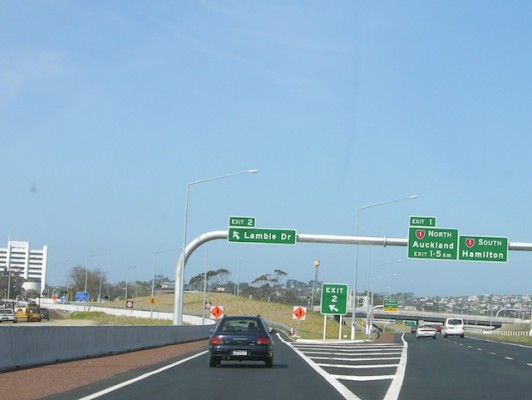 The report says that presently the corridor doesn’t function as a motorway as it has been necessary to introduce mainline ramp metering into SH20 to restrict capacity to maintain network balance between vehicle demand on SH20 and SH1 southbound in the pm peak. The impact of SH1 of unconstrained demand on SH20 was seen on the network in August with pm peak delays on SH1 extending back 10km on Mt Wellington highway.
The report says that presently the corridor doesn’t function as a motorway as it has been necessary to introduce mainline ramp metering into SH20 to restrict capacity to maintain network balance between vehicle demand on SH20 and SH1 southbound in the pm peak. The impact of SH1 of unconstrained demand on SH20 was seen on the network in August with pm peak delays on SH1 extending back 10km on Mt Wellington highway.
In order to bring “full functionality” to the network and optimise the WRR and SH1 in the south, it’s considered a further package of improvements i required to be brought forward to SH1 south of SH20 over the next 10 years.
- Stage 1: Hill Rd to Takinini southbound 3-laning ($40m-$80m) BCR 3:4
- Stage 2: SH20 to Hill Rd southbound 4-laning
- Stage 3: Takanini to Papakura 3-laning
- Stage 4: Takinini interchange upgrade
It’s believed the ramp metering could not be fully removed until completion of stages 3 or 4.
Northern Motorway
On completion of Waterview, State Highway 18 at Constellation Drive will be the final piece of the WRR which is considered not to expressway standard.
SH1 Constellation to Greville is located at the nexus of three RONS projects, the WRR, Vic tunnel and Puhoi to WEllsford.
The board report says there are presently significant capacity constraints in the SH18/SH1 corridors around Constellation and on completion of Hobsonville in 2011 this is anticipated to worsen as wider northbound capacity becomes enhanced.
The long term plan for the SH1/18 intersection has always been grade separated motorwats to motorway movements. The NZTA has completed a further review which has reinforced this approach and confirmed that a motorway to motorway configeration can be adopted which future proofs busway extensions north to Orewa and west towards Hobsonville. The busway extension northbound is “currently subject to further investigation by the NZTA.”
For this area, it is recommended:
- Stage 1: SH1 Constellation to Greville Rd 3- laning Northbound ($50m-$80m) BCR 3.3
- Stage 2: Sh18 upgrade to motorway standard and grade separation to Sh1 (north facing ramps only) and SH1 3-laning Southbound ($400m-$600m BCR 3.4)
- Stage 3: Greville Rd interchange upgrade ($75m-$150m BCR 4.6)
The report says there is currently significant congestion experienced on SH1 at Constellation in the pm peak period brought about by insufficient capacity on the Northern Motorway to accommodate the merge demands from Upper Harbour Highway at Constellation Drive / Western Ring Route.
The recently completed study examined northbound hard shoulder bus lanes between Constellation and Greville as a means to mitigating these issues and contributing further to the success of the busway.
The study found that this would be $27m with a BCR less than 1. Hence the study concluded that the general capacity increase with bus hard shoulders at a cost of $20m more and BCR of 3.3 was the preferred option.
In the background
Other significant projects under consideration and will form part of the Auckland Plan discussions:
- The next harbour crossing
- The East-West link “rung”
- SH16 Port upgrade
- SH2OA/B upgrades
Rail electrification impacts
Another project is the completion of the northbound auxilliary lane between the Ellerslie-Panmure Highway and Greenlane on SH1. Presently the existing lane is only provided for half of this seciton of the motorway due to the previous designation and rail alignment issues when the project was investigated and represents a significant bottleneck on this section of the SH.
In recent months, NZTA has been approached by KiwiRail to work collaboratively with them on delivering the remaining section ahead of rail electrification. This presents NZTA with a limited opportunity to provide for the upgrade of this section of the network ahead of rail electrification later this year after which the costs and design implications for both agencies will make it more compelx and costly.
A recent update of the project in light of the Kiwirail offer has indicated the the project would cost in the order of $15m-$20 to design and construct “but it has a significant BCR of 7.6.”

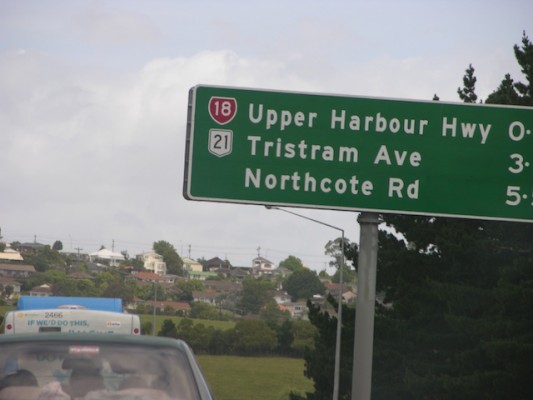
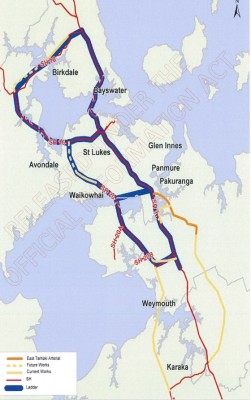
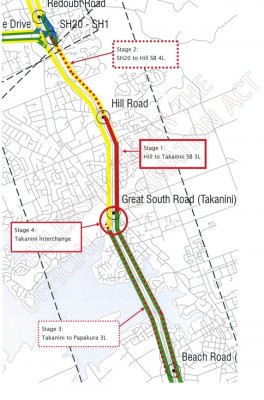
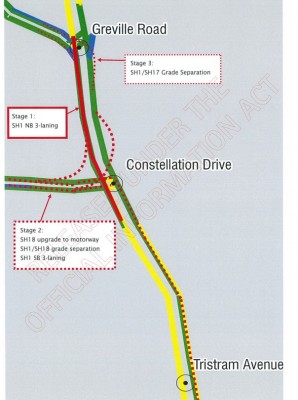










36 Comments
Interesting. I remember talk of “completing Auckland’s motorway network” before, and I do not recall it including any of the lane widenings talked about here.
The goalposts have moved? The “middle rung” Penrose-Onehunga link wasn’t in the original plans either when we started hearing that phrase.
Wow those northern motorway stage 1 -3 BCR’s came out quick! Or did some one just pull those numbers out of a hat?
You’d laugh if you din’t know they were actually serious. They really do think this will solve Auckland’s congestion. Of course we know once all this is done and Auckland is still choking on it’s own traffic they’ll come up with another list of projects that they are sure will ‘complete’ the network and get traffic flowing.
The very definition of stu[pidity is doing the same thing over and over and expecting a different result. I’m starting to think things will never change, maybe time to look at moving overseas.
I’d have thought they’d have no spare money right now, given that every surplus cent is meant to be going to CHC at this point.
Yep definitely a shifting of the goal posts, as noted the motorway network will never be ‘completed’ and part of the problem is that if they did the construction companies would be upset there wasn’t as much for them to do.
Roads will always be congested no matter what you do. The difference being is that you’ll move more people in that time.
Building more rail will not solve congestion problems at all, all it will do is help to move the same people via a different network.
Road space will be used if it is available, so it is better for all of us if we have more space available to move more people.
Cities around the world with great PT systems, such as Paris, Berlin, London, NYC still have massive congestion problems.
this work alone could probably almost fund the CBD rail link! riduculous claiming the CBD rail link needs to be canned but this package gets the go ahead.
I think these projects should be on the 20 or 30 year plan but there is no urgent need for them.
This also shows the danger of he hopelessly amateur SH classification proposal which is based upon very unscientific methods.
@Matt This board paper was prior to last week’s quake
Damian, the problem we have is that the only solution espoused by the current lot is “more roads”. As you observe, you can never build enough roads to resolve the problem. So, other ways of moving large numbers of people are required as well, which is where rail comes in.
@ Damien. If people catch trains rather than driving, they are taking up a fraction of the space- 1 rail line apparently has the same capacity as 5 lanes of traffic.. It is therefore far cheaper, and screws up far less of our city if we move people by these more efficient means. Also, people need an alternative means of travel to the CBD especially, as there is no space for more roads- they can widen the motorways to 20 lanes wide, but they will still be congested as there is no where for the cars to go when they get to the city.
Public transport can solve a lot of congestion- for example over 40% of people who use the harbour bridge during peak time now are bus passengers, but buses contribute near nothing to its traffic .Also, I live just off Dominion Road, 5 km from the CIty. During peak time buses carry over half of the roads users- and each bus passenger takes up less than 10% of the space of a car user on average. It takes 40 mins to drive to work, or less than 10 on the bus….if it werent for the efficient bus route, everyone would probably take over an hour to do that trip…no quick options for anyone. So basically, there is way less congestion for cars at little monetry or environmental cost, and pretty much no congestion for bus passengers. Therefore, on Dominion Road at least, congestion has been completely solved already for over half its peak users. so Damien, there isnt always congestion- even at 8am on one of Aucklands main arterials.
Also, those other cities you mention all have considerably bigger population than ours- so you cant really compare… and if things dont change before we are their size, there will be no comparison.
The CBD is deminishing as a place to work, more and more businesses are heading out of the “CBD” so increasing the links to the city is not really warranted considering there will be less demand over the coming years.
The upgrade and extension at Takanini will have a far greater impact on congestion than a CDB rail link will ever have.
I am pleased to hear PT in the form of buses is working on Dominion Road, just goes to show that rail is not the be all and end all to reduce congestion.
Comparing cities like London and Berlin is warranted, their population base makes PT worthwhile whereas Auckland’s population is not at that level yet.
Sure we have to plan for the future and rail is one of those options, but as we can not afford it, we should concentrate on projects that will actually make a difference in the short to medium term.
That’s simply not true Damian, where exactly did you hear that?
The fact is more and more businesses are locating in the CBD. According to Statistics NZ, over the eight years to 2008, the number of jobs in the CBD rose from 79,240 to 92,500. This represents growth in the number of jobs in the CBD of 17%.
That’s and extra 13,260 people working there than ten years earlier. You can’t claim it is “deminishing as a place to work, more and more businesses are heading out of the “CBD” when thirteen thousand extra people have started working there!
“Roads will always be congested no matter what you do” - Exactly my point. However by building more roads you exacerbate congestion.
“their population base makes PT worthwhile whereas Auckland’s population is not at that level yet.” Perth and,Brisbane are both comparable by population and all have extensive electric metro rail systems. Please don’t com on hear and spout the same old discredited nonsense about Auckland not having the population or/and density to sustain a metro rail system it’s just rubbish.
Damian, the independent consultants who evaluated the CBD rail tunnel business case would disagree with you quite strongly. They see the CBD as growing, with or without the tunnel.
“Cities around the world with great PT systems, such as Paris, Berlin, London, NYC still have massive congestion problems.”
A great PT city may still have congestion, but you have a way around it, and can be reasonably certain of arriving on time via the alternatives. In Auckland, if the road is stuffed, you normally have ZERO alternatives, unless you happen to live next to one of the few rail lines, as the relatively few buses are also stuck in the same congestion, and walking & cycling as so hostile most people don’t bother.
No options. You are stuck because we have all our eggs in ONE basket. A basket just waiting for the next fuel price increase, BTW.
Investing in PT is also a simple matter of “diminishing returns”. Every mode has its strengths, and if you try to do everything with only one mode, you will get places and times and peaks where doing it will cost you two, three, four times as much as with the other mode. We have long since reached that point, and are throwing more good money after bad.
How many billions do you want to spend on more motorway widening to get another 1000-2000 cars per hour through a road? How many houses to bulldoze just for that, just so the cars can run into the back of a traffic jam 500m further down the road? How many more on-ramps clogging back into residential streets?
Stops the addiction to roads before we have to go cold turkey in the next fuel crisis.
Perth has 25% more people than Auckland is roughly half the size, so comparing Perth to Auckland is a little misguided. Nothwithstanding that, Perth and Brisbane still have their congestion issues which have not be solved by PT
And yes people are moving out of the city, any quick search on google will provide the numerous links to what people and even the Auckland City Council have to say.
And Cam, before you start foaming at the mouth. I am in favour of rail, but my it is my opinion that it can wait and that it should be the least of our worries right now.
Damian, if the number of jobs in the CBD is growing according to the arbiter of all things statistical, then does it actually matter a damn if people are also leaving? Clearly more are coming than going, which is what ultimately counts.
yes Matt and they are coping just fine at the moment.
I believe Damian is referring to the recent dip in CBD job numbers following the financial crisis. While this does represent a small drop in CBD jobs since 2008, it is only because the number of jobs throughout Auckland has dropped, they’ve dropped in East Tamaki, Albany, Otahuhu, Takapuna and anywhere else you care to mention.
People aren’t leaving the CBD to work elsewhere, we are just experiencing more unemployment in general.
If we look at the long term trend and smooth out the effects of the economy fluctuating, the Auckland CBD has grown by around 1,500 new jobs a year for the last 20 years.
Damian, and when the economy starts to grow again, and the numbers employed in the CBD jump, then what? What’s your master plan for sustainable employment growth in the highest-value area of employment in the country? We can’t pave the whole city, and we can’t take up CBD roads with double- or triple-lane bus-ways that’ll be required to bring people into the CBD for work and study.
Matt
I am not sure how many times I have to write this, but when the economy starts to grow again, properly, then we should invest in rail. But at present delay of one or two years is going to do no harm.
And even then, if the CBD does suddenly grow again, people will have to leave abit earlier or later. At 7.15am on a week day the CBD is a ghost town, so there is plenty of scope for movment, most of the congestion is not in the CBD but from people passing through the CBD motoway junctions. Having a rail link wont solve that problem.
Damian, you’re getting us confused because you talk of the need to invest in roads right now but rail can wait. If we need roads now, we need rail now for precisely the same reasons - to transport people efficiently and quickly. Rail does a much better job, and considerably more safely, than road ever can.
Matt
I dont see what the connection is between the Takanini Project’s and the CBD link is?
The Takanini project(s) is a far better use of money at the present time and will benefit more people and industries than a CBD rail link will ever do
Damian you should quote numbers and sources if you are going to make claims that include words like ‘more’ and ‘ever’. If you’re just interviewing your own feelings that’s sweet but not particularly helpful or persuasive.
The fact remains that whatever is invested in will be used, especially if that is the only thing invested in, so your arguments are circular, and so are the PT advocate’s. The point is that if we build a viable rail network to balance the existing car one we will have a better quality of life in Ak- by preventing the city from becoming even more swamped by cars and parking than it already is, we will have much more resilience to increases in oil price- by having an efficient electric network to use instead, we will have a system that costs us all less to use- as transit based on the private car is the most expensive way to order a city, we will have better air quality… I could go on.
It is a choice we really need to make as soon as possible, as the longer we keep investing in the wrong mode the more painfully it will be to change as it’s unsustanibilty becomes more and more apparent.
We’ve got more than enough roads, pouring billions of dollars more into them will not improve the quality of life in AK for anyone- they just fill up the moment they’re built. What we have far too little of is any viable alternative to roads.
I suspect you don’t see yourself using a train, this is the source of your anger about any money being spent on the network. Well you are still the main beneficiary of the network for without it the roads would be even more congested. NZTA now says that every peak user of a train earns road users $19 in road savings per trip! The roads only work, and this is especially the case in the CBD, because of those not using them, and of course they still pay for roads through their rates and taxes. So please don’t get upset, you are being subsidised by others.
And the link between Taknini, in fact many road plans that NZTA has, and the Rail network is that Joyce and others claim that there is no money for rail. Our argument is simply that heaps of money is about to be spent on roading projects THAT HAVE LESS BENEFIT than the modeling shows will accrue from building this and other rail schemes.. And this is using their own BCRs.
All we want is a level playing field, a rational basis for deciding what to invest in.
Damian you’re right the current BCR model is poor. Its is poor because so much cost is uncounted when they examine road projects. The cost of the car, the fuel, the places to park them are not counted. With rail they count the cost of the train, the running of the train, the stations, depreciation of the track and the rolling stock [pretty abstract], margin for the operators the list goes on….. indeed it is so far from apples with apples. You try using a motorway with no car, or no petrol, or nowhere to park at your destination, yet these are all real costs borne by all of us if are to function with this system.
Anyway what’s with your timing idea? It’s like St Augustine: ‘lord make me good, but not yet’. Bollocks, this is needed now, hell it was needed 20, 50, years ago…. the numbers stack up now, we will never be able to afford it more than now, inputs, especially energy are getting more expensive. Without protecting routes [we don't even do that!] the property costs are only going up. Also delay is the road lobby’s big strategy, get in, spend it all, commit the nation to road and stuff the common good. Delay means never.
This idea that good planning and wise decisions can only happen when you have the population of India, the density of Manhattan, and the rices of Abu Dhabi is clearly upside down. What did Rutherford say: ‘we’ve got no money so we have to think.’ We can’t afford to keep building roads. Don’t listen to the pusher, don’t unquestioningly spout the road lobby’s nonsense.
Damian you’re right the current BCR model is poor. Its is poor because so much cost is uncounted when they examine road projects. The cost of the car, the fuel, the places to park them are not counted. With rail they count the cost of the train, the running of the train, the stations, depreciation of the track and the rolling stock [pretty abstract], margin for the operators the list goes on….. indeed it is so far from apples with apples. You try using a motorway with no car, or no petrol, or nowhere to park at your destination, yet these are all real costs borne by all of us if are to function with this system.
Anyway what’s with your timing idea? It’s like St Augustine: ‘lord make me good, but not yet’. Bollocks, this is needed now, hell it was needed 20, 50, years ago…. the numbers stack up now, we will never be able to afford it more than now, inputs, especially energy are getting more expensive. Without protecting routes [we don't even do that!] the property costs are only going up. Also delay is the road lobby’s big strategy, get in, spend it all, commit the nation to road and stuff the common good. Delay means never.
This idea that good planning and wise decisions can only happen when you have the population of India, the density of Manhattan, and the rices of Abu Dhabi is clearly upside down. What did Rutherford say: ‘we’ve got no money so we have to think.’ We can’t afford to keep building roads. Don’t listen to the pusher, don’t unquestioningly spout the road lobby’s nonsense.
Patrick you are right, there is a need for rail, but its not now when we can least afford it.
The problem with BCR’s is that they measure the parties effected by the benefit, so essentially you are not comparing apples with apples. ( as far as I understand)
Damien- what was the population of Perth and Brisbane when they elcectrified and began to expand their urban rail networks in the late 80′s and late 70′s respectivley??Answer is the same(Perth) or less (Brisbane) than Auckland’s is currently.
Also as people have stated time and time again nobody has suggested PT solves congestion. Who actually said that? What is does is allow people to move easily around a city without a car and avoid congestion if they choose. Currently we don’t have the option and many people waste hours of their day because they don’t have any choice but to do. Not really very productive is it?
You can be against rail if you like, ‘what makes me foam at the mouth’ is people who state emphatic opinion despite an apparent complete ignornace of the subject at hand and without any hard facts to back up them up.
cam,
i am in favour of rail where did you get the idea I am not. My point is about timing. Not sure why this is so fhard to comprehend?
by the way, what facts do you need backing up?
Given that motorway construction is continuous, always chasing the moved goalposts but never reaching them, there is no right or wrong time to build the CBD tunnel in relation to motorway building.
The road planners do understand that building roads doesn’t solve congestion, they just won’t admit it publicly. They are in the business of building roads, and they don’t want to reach a stage where there are none left to build.
the BCR of all of these projects, along with the whole of the Western Ring Route should have been calculated at once. The BCR for these projects may look good, but thats only because of the increased traffic from the previous projects.
That would have given a true cost and benefits of the WRR.
Great to see the NZTA and Government are so backwards in transportation thinking.
So glad the Swiss saw the light many many decades ago. Such beautiful liveable cities here … so easy to live without a car thanks to great public transport.
damian - I understand what you are saying, and with the Earthquake down in CHch I would agree with you, however roading and rail projects should be on hold. The fact is cars entering the city via the motorway are holding up vehicles who need to use the road for valid reasons. If you have ever spent time stuck on the southern motorway, southwestern motorway or the northern motorway even the northwestern motorway you will understand the need for rail over roading.
I agree it’s not time right now to spend because of the situation, but I argue that the CBD tunnel is more important to the city than any road project at the moment.
honestly, if we keep on going like this then by the time they have finished these they will be wanting to add another 2 lanes to SH16, and Waterview and we’ll just keep going and going until there are no houses left in Auckland - just giant motorways…
Go LucyJH!
Yeah bugger it - let’s just make all motorways 10 lanes in each direction and demolish the city.
After all the city only delays the journey home for Joycey, Lockwood et al.